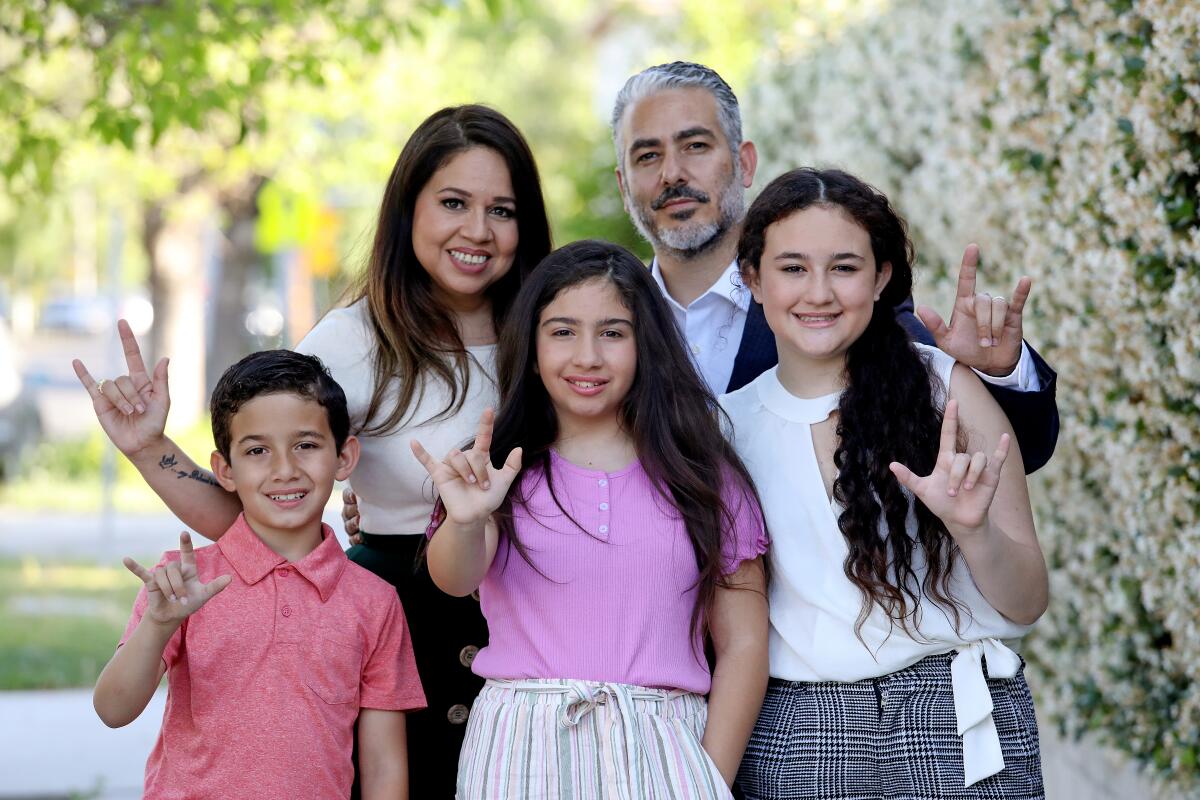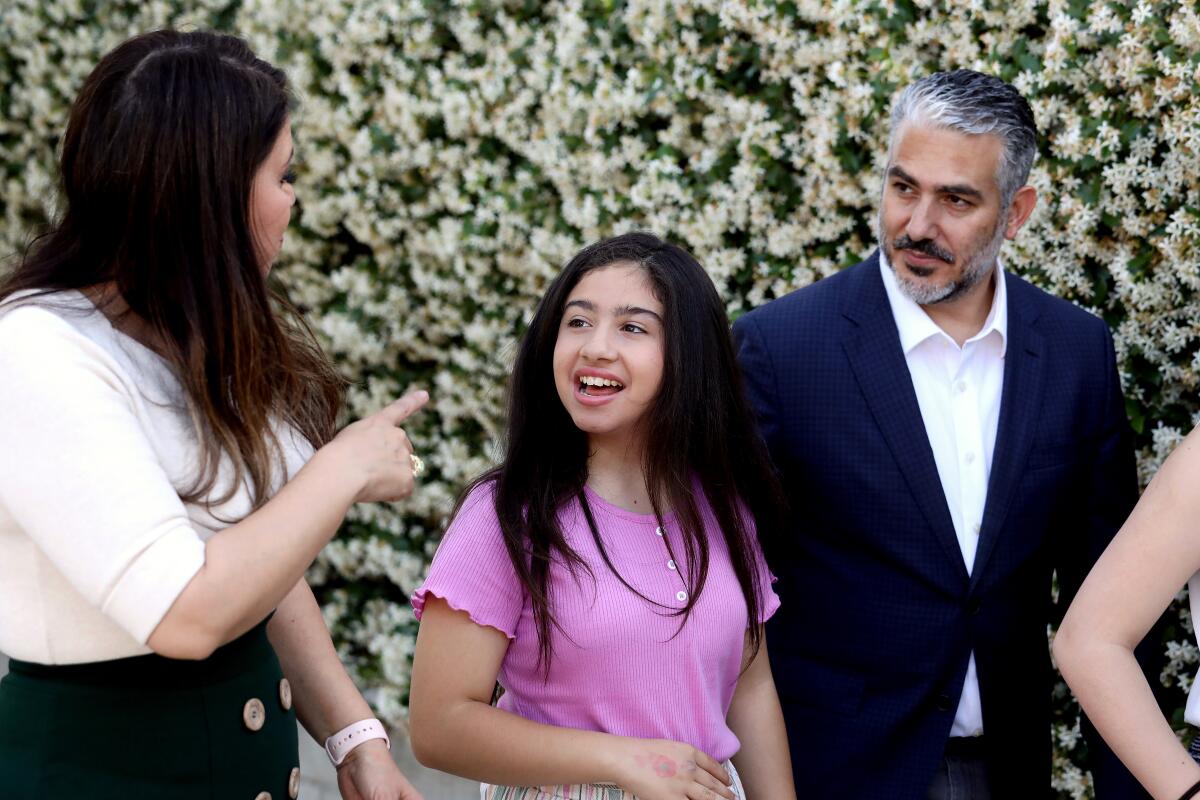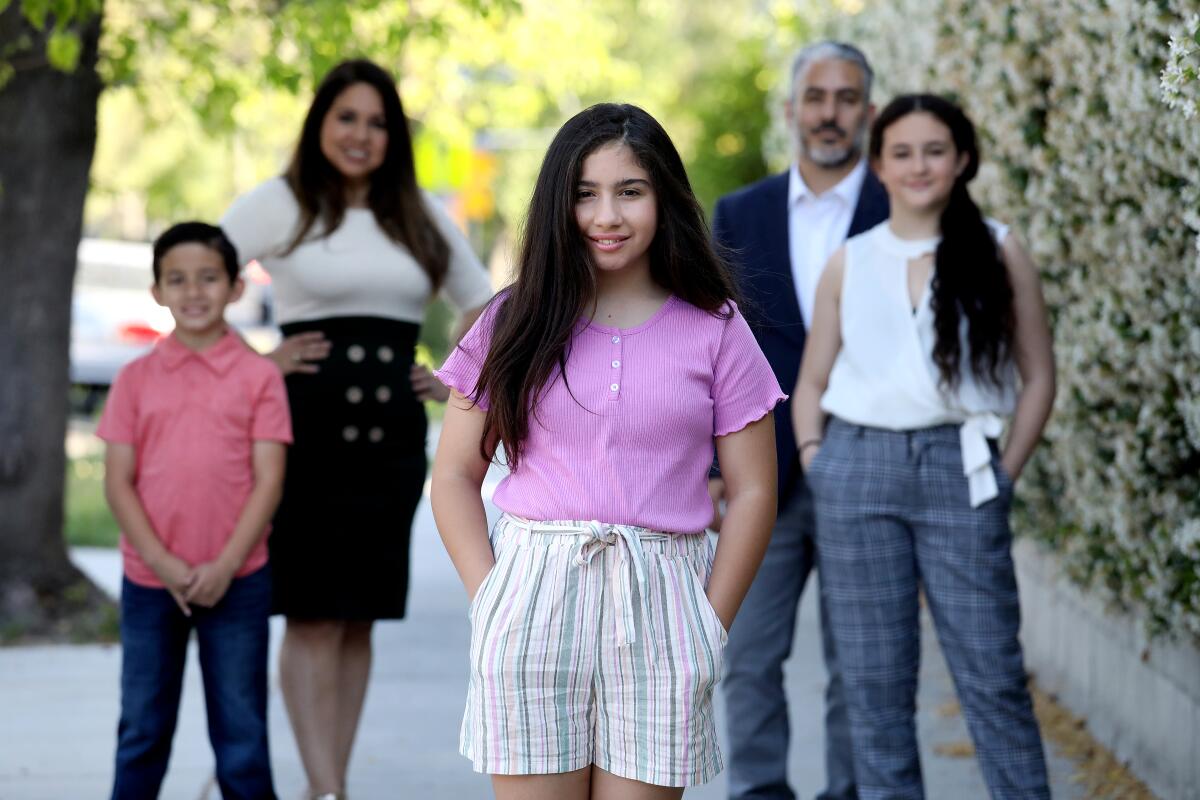Deaf education vote is the latest parents’ rights battleground in L.A.

The Los Angeles Unified School District is poised to vote on a controversial proposal that could reshape education for thousands of deaf and hard-of-hearing students, a key battle in a long national fight over how such children learn language.
Oscar winner Marlee Matlin and the American Civil Liberties Union are among those urging the Board of Education to pass Resolution 029-21/22 at its meeting Tuesday, inaugurating a new Department of Deaf and Hard of Hearing Education.
The move would elevate American Sign Language alongside Korean, Mandarin, French, Arabic, Armenian, Japanese and Spanish in the district’s dual language and bilingual program. Students would be eligible to receive the state seal of biliteracy on their diplomas, and ASL would be offered as a language course in some high schools.
The resolution also would introduce ASL-English bilingual instruction for many of the district’s youngest deaf learners — a move supporters say is critical to language equity and opponents say robs parents of choice and runs afoul of federal education law.
“For 400 years at least there’s been a big battle between people who think children with hearing loss should speak, and people who think they should use sign language — it’s a very old argument,” said Alison M. Grimes, director of audiology and newborn hearing at UCLA Health. “This is the leading edge of a nationwide push to have all early intervention programs be more cognizant of and more balanced or more open to having kids use ASL. It’s very controversial.”
Currently, the majority of the district’s roughly 2,100 deaf and hard-of-hearing students learn in oral classrooms, either in general education or in hearing special day classes. They begin early intervention programs in infancy and transition to district preschools at age 3, before most are ever exposed to ASL.
Typically, only those who cannot access spoken language at all or who “fail out” of mainstream classrooms are offered ASL, often in the form of “total communication,” which supporters of the resolution say lacks the rigor of a bilingual model. The ‘80s-era educational philosophy combines instruction in ASL and spoken English with lip reading, gestures, finger spelling and “signed English,”,a method both sides of the current debate agree doesn’t work.
“This is not a new fight for us — this is something that we have been fighting for, and finally we have the attention of the LAUSD board,” said Janette Durán-Aguirre, a school counselor for the district, who is Deaf and supports the proposal. “Especially for marginalized families, BIPOC families, families who don’t use English at home — these kids have been deprived on top of deprivation, on top of marginalization. We’re doing this for these students.”
Many deaf educators, activists, district parents and students agree, pointing to years of research showing that, although early intervention programs begin in infancy, most deaf and hard-of-hearing children still enter school with significant language delays.
The studies show that those in the LAUSD are roughly half as likely to test as proficient in English/language arts as their nondisabled peers.
But hundreds of others, including many parents and listening and spoken-language specialists, say American Sign Language is being forced on them by a radical fringe.
“My daughter can hear amazingly well [with assistive technology], we do NOT need sign language,” Van Nuys mom Hailey Cohen wrote on a Change.org petition opposing the rule. “This is a horrendous violation of our freedom and rights as parents.”
The debate over whether and how to introduce ASL in the country’s second-largest school district is the latest salvo in a fierce and enduring conflict that has only deepened in recent years, as newborn screenings have become universal and cochlear implants are approved for children as young as 9 months.
In L.A., this longtime conflict is being argued in decidedly 2020s terms, with supporters adopting the language of equity and inclusion, and opponents trumpeting parents’ rights and decrying government overreach.

“Parents are their children’s first teacher, not the school district,” said Donna L. Sorkin of the Cochlear Implant Alliance, who is deaf and opposes the change. “They’re going to require every child to learn ASL, and if that’s not the family’s desire, that’s a violation of federal law.”
The federal law in question is IDEA — the Individuals With Disabilities in Education Act — which gives parents of disabled children significant input into what educational services and accommodations their children receive.
It also requires that students be placed in the “least restrictive environment,” a provision that emerged from a long and shameful history of segregating deaf and blind students in underfunded and substandard schools, warehousing those with physical disabilities in basements and denying admission to intellectually disabled children, among other forms of exclusion and abuse.
Supporters say their resolution and the law aren’t in conflict, that framing the issue with parents on one side and activists on the other ignores how most parents of deaf children understand the options they’re being given when they’re asked to choose between spoken English and ASL.
Indeed, the vast majority of parents of deaf children have never met a deaf person before their infant is handed to them in the delivery room, nor are they likely to meet one among the audiologists, otorhinolaryngologists and other pediatric specialists their child will see in their early years.
Studies show such children enter school with far lower language proficiency than those raised by deaf parents, whether or not the children use spoken English or sign language in the classroom.
“Parent choice ... is being used as a weapon,” said Mallorie Evans, an educational audiologist who supports the proposal. “You can’t make a choice when you don’t have information.
“In the beginning, you should be providing families with everything,” she said. “That’s not the same as saying ‘every single child who comes to LAUSD must learn ASL.’ What it’s saying is that ASL and English, whether spoken or visual, should be offered systematically to all families” of deaf and hard-of-hearing children.
Opponents say that logic doesn’t square with the demographics of deafness, since most children served by the district’s existing program have at least some hearing — including many who are hard of hearing in only one ear — and most of the rest now receive cochlear implants in infancy or early toddlerhood.
Rather than amplifying sound, as hearing aids do, cochlear implants send electrical signals directly to the auditory nerve, via an implant in the inner ear combined with an external sensor. With training, the device will allow most users to hear and understand speech. But it can also be exhausting to use, and often requires surgical revision to work optimally.
Experts point out that not every family has the same access to high-quality, well-fitted hearing aids, or to the surgical revisions and training necessary to use a cochlear implant successfully. Nor can families predict ahead of time how well an implant will ultimately work, or what degree of hearing the child will retain over time.
“You need a lot of services, and Medicaid doesn’t fully cover that,” said Tawny Holmes Hlibok, the language planning and policy counsel at Gallaudet University in Washington D.C., who is Deaf. Children under 5 “who got technical devices might still have struggled with acquisition of language. Only a very small percentage, those [whose parents] are white and well-educated, got the services they need.”
That leaves many of the most marginalized students without meaningful language access, supporters of the resolution say.
“ASL was not even offered to my parents,” LAUSD’s Durán-Aguirre said. “I work with so many families, and many of them are clueless, they’re lost, they have no idea where to begin. What are the options? Which one is best? How do I pick something? Until their kids fail out of other programs and as a last resort they get placed in an [ASL program].”
The alternative she and others envision is closer to the bilingual and dual-language immersion programs that have proliferated across the district in the last decade, including a new Japanese program in 2021 and Filipino one in the 2022-23 school year.
Opponents say bilingual instruction is a burden for parents and a stumbling block for deaf children, who already lack the passive exposure to language that hearing babies get every day. But supporters say language deprivation is a more urgent crisis, one existing interventions have failed to solve.
“In our representation of many deaf adults who’ve been drawn into the criminal legal system around the country, we’ve seen the adverse affects of childhood language deprivation,” said attorney West Resendes of the ACLU’s national disability rights program, who is deaf. “The idea that you could acquire a signed language and that would impede your ability to acquire a spoken language is just not supported by the research.”
Instead, children like Ellie Shmilovich are forced into options that don’t fit them.
“Sometimes I would really struggle,” being the only Deaf student in a classroom, said the sixth-grader, who recently gave an enthusiastic presentation on the silent-film star Charlie Chaplin to her hearing classmates at Nobel Middle School in Northridge. “I don’t know if the other kids learned anything or not — my friend told me they weren’t really listening, because at times the interpreter was trying to get caught up.”
Like most deaf children in the district, she was fitted with a cochlear implant as an infant and placed into a speaking-and-listening early intervention program. Her parents, who had grown up bilingual in Hebrew and Spanish, respectively, and who each spoke their own native language with their older daughter Estie, were given strict instructions to create a monolingual environment for their second child.

“We were directed to [speak only English],” Ellie’s father, Alon Shmilovich said. “We eliminated all the other languages from our house, and all we focused on was spoken English, trying to get her to speak a language she would never hear.”
Although they began learning ASL as a family when Ellie was 2,Heidy Alvarenga said her daughter was forced to “fail out” of a mainstream kindergarten before being placed in an ASL program, only to leave because the other children were just learning to sign, while she was already fluent.
Ultimately, Ellie ended up with an interpreter in a mainstream classroom, where she is doing well. But her parents grieve the opportunities she might have had in a bilingual program.
“I had all this misinformation that I built my parenting around,” Alvarenga said, fighting back tears. “I deprived my children of our culture, our languages, all because I wasn’t provided choices.”
More to Read
Sign up for Essential California
The most important California stories and recommendations in your inbox every morning.
You may occasionally receive promotional content from the Los Angeles Times.











